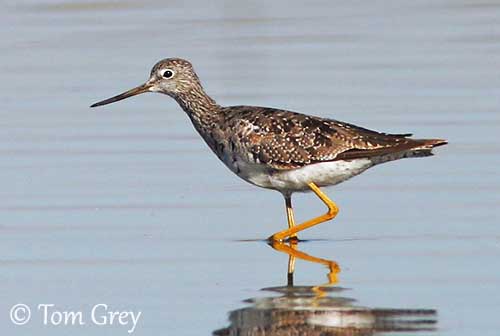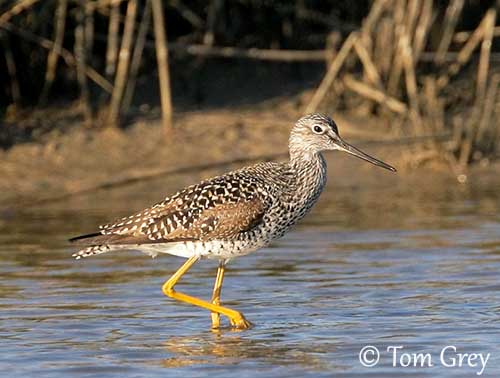
Fr: Chevalier criard
All: Großer Gelbschenkel
Esp: Archibebe Patigualdo Grande
Ita: Totano zampegialle maggiore
Nd: Grote Geelpootruiter
Sd: Större gulbena
Photographer:
Tom Grey
Tom Grey's Bird Pictures
Text by Nicole Bouglouan
Sources:
HANDBOOK OF THE BIRDS OF THE WORLD Vol 3 by Josep del Hoyo-Andrew Elliott-Jordi Sargatal - Lynx Edicions - ISBN : 8487334202
GUIDE DES LIMICOLES de D. Taylor - Delachaux et Niestlé - ISBN : 2603014080
BirdLife International (BirdLife International)
Animal Diversity Web (University of Michigan Museum of Zoology)
All About Birds (Cornell Lab of Ornithology)
What Bird-The ultimate Bird Guide (Mitchell Waite)
Bird Web (Seattle Audubon Society)
Greater Yellowlegs
Tringa melanoleuca
Charadriiformes Order – Scolopacidae Family
INTRODUCTION:
The Greater Yellowlegs is a large shorebird, very similar to the Lesser Yellowlegs, but larger and heavier. This species is an active feeder. It breeds in bogs and marshes in the boreal forest, before to migrate southwards to its winter areas.
DESCRIPTION OF THE BIRD:
Biometrics:
Length: 29-33 cm
Wingspan: 70-74 cm
Weight: 110-235 g
The adult in breeding plumage has dark brown back and upperwing with black-and-white spotting. Head, neck and breast are streaked with black. Flanks and upper belly are spotted blackish, whereas the lower belly shows sparse dark bars. The rump is white.
On the head, we can see a white supercilium. Lores are dark grey.
The long, slightly upcurved bill is black with paler base. The eyes are dark brown, surrounded by white eyering. Long legs and feet are yellow.

Both sexes are similar. In non-breeding plumage, the upperparts are greyish-brown with fine white spots and feather edges. Breast and flanks are streaked with grey. The underparts are white. The tail is narrowly barred black-and-white. Legs and feet are duller yellow.
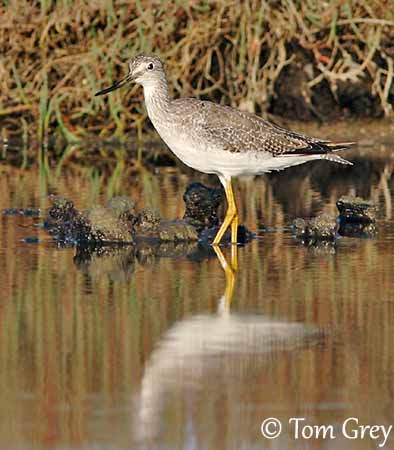
The juvenile resembles non-breeding adult, but it often shows a breast band formed by buff spots and brown tinge.
RANGE:
The Greater Yellowlegs breeds from S Alaska and British Columbia, E to Labrador, Newfoundland Is and NE Nova Scotia.
It winters along the coasts of N America from British Columbia and the Carolinas, through Mexico, Central America, West Indies to South America, and S to Tierra del Fuego.
HABITAT:
The Greater Yellowlegs breeds in open marshy areas with scattered trees, in subarctic tundra and often on fairly flat grounds.
After the breeding season, it frequents both freshwater and brackish wetlands, ponds with emergent vegetation, flooded areas, mangroves, salt-marshes, muddy coasts and intertidal flats.
During winter, it is mainly found on lagoons and intertidal flats. It can be occasionally seen in drier habitats, pastures and dunes, and some of them occur up to 4600 metres of elevation at streams and pools.
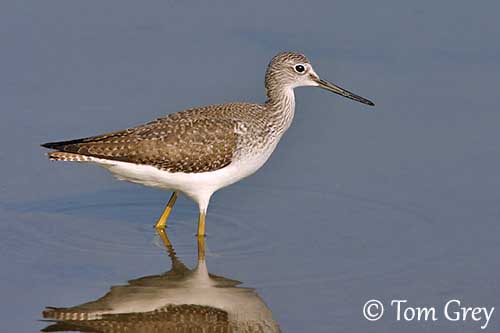
CALLS AND SONGS: SOUNDS BY XENO-CANTO
The Greater Yellowlegs utters some descending notes “hiou-hiou-hiou”.
The courtship song is a loud “ouiih-oudel-ouiih-oudel”. It also utters series of musical whistles “whew-whew-whew”.
This species is known for its piercing alarm calls. It is a fairly noisy bird.
BEHAVIOUR IN THE WILD:
The Greater Yellowlegs feeds primarily on aquatic preys such as crustaceans, fish, worms, aquatic insects and their larvae. It also takes amphibians, terrestrial insects (grasshoppers, flies and ants), seeds and berries.
It feeds on insects along the shores, but also snatches them in the air. It can be seen skimming the water surface, or picking preys below the surface in shallow water. It wades, and even swims.
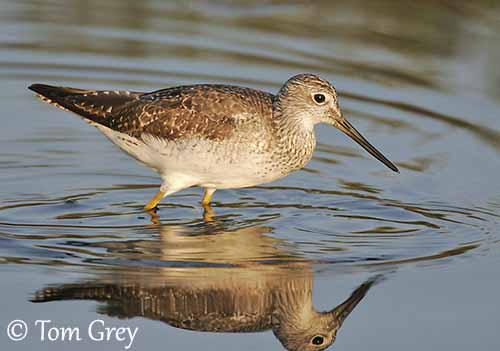
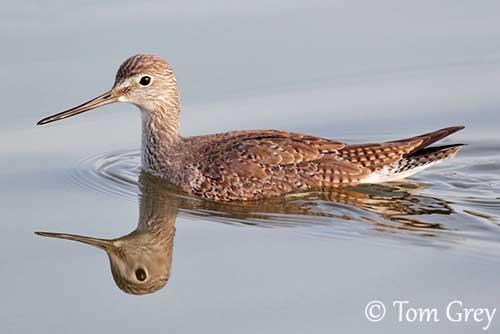
It usually defends its feeding area, and outside the breeding season, it feeds singly or in small groups. This species is both diurnal and nocturnal forager.
It feeds actively, often running after fast-moving preys. It often bobs the front half of its body up and down. This is a typical behaviour in genus Tringa.
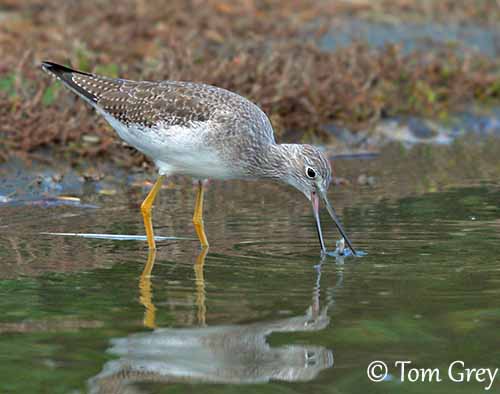
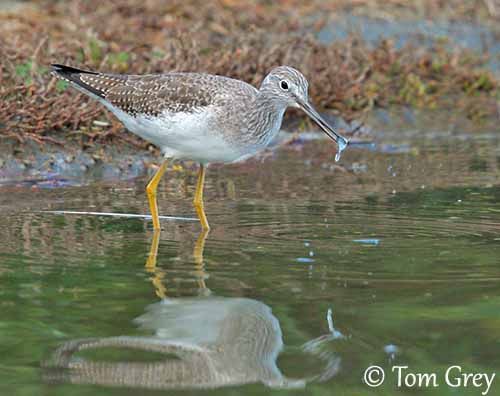
During the breeding season, the Greater Yellowlegs performs aerial displays with ascents and dives. Another display shows the male running around the female while quivering its raised wings. This “dance” can be longer when the pair is forming, but in established pairs, this display only lasts a few seconds. The copulation may follow these displays. They are monogamous.
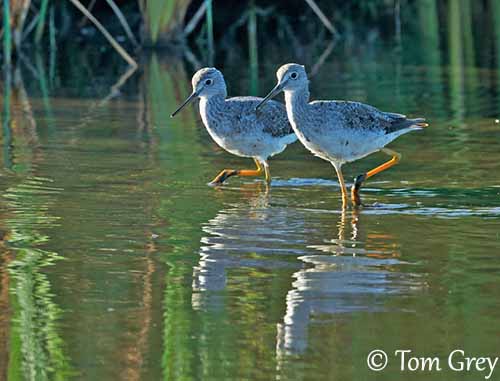
The Greater Yellowlegs migrates S in winter, through interior of North America and along the coasts for both passages. The eastern birds travel along the Atlantic coast or from Florida, across Great Antilles to South America. The return flight is across central North America and up Atlantic coast for most of them.
They have a strong, powerful flight.
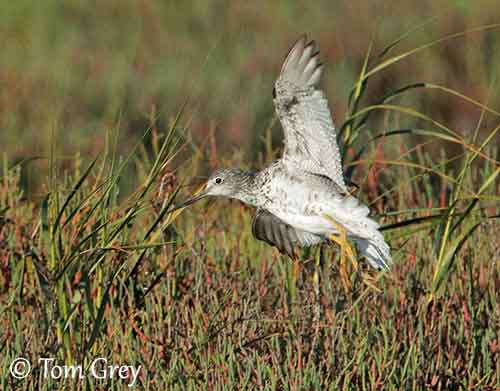
REPRODUCTION OF THIS SPECIES:
The breeding season starts in May.
The Greater Yellowlegs is solitary nester. It breeds in marshes, freshwater, swamps and grasslands.
The nest is placed on the ground and close to the water. This is a shallow depression well concealed under low vegetation. It is sparsely lined with grass, leaves, twigs and lichen.
The female lays 3-4 buff eggs with brown and grey markings. Both sexes incubate during 23 days. The chicks are able to leave the nest soon after hatching and to feed themselves. But both parents tend them until they can perform fluttering flight, about 25 days after hatching. They fledge at about 35-40 days old.
This species produce a single brood per season.
PROTECTION / THREATS / STATUS:
The Greater Yellowlegs is not globally threatened. The overall population is stable and this species has shown a significant increase over the last 40 years in North America.
